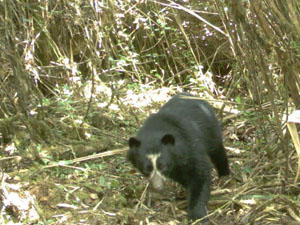Pyramid lives on!
 |
|
Pyramid photo-captured in 2012 |
|
Cuenca, Ecuador (28 Jan. 2014) – Pyramid lives on! A uniquely patterned Andean, or spectacled bear, with a white inverted pyramid on its brow has appeared once again in our forest photographs. First photographed in 2009, Pyramid has been consistently identified in photographs over the past three and a half years. Today Pyramid continues to live within a private reserve abutting Sangay National Park, one of Ecuador’s largest national parks.
Becky Zug, doctoral candidate at the University of Wisconsin-Madison and Fundación Cordillera Tropical Senior Scientist, uses the patterns of unique white fur on the face and chest to differentiate individual bears. This data collection allows Zug to study individual bear survivorship and persistence over time on private land directly adjacently to Sangay National Park.
State- of-the-art motion sensor cameras have photographed Pyramid in a 2,500 hectare region covered with cloud forests and grassy high-elevation páramos that straddles some 15 private properties. This region also supports at least five other Andean bears, suggesting that Pyramid shares its territory.
Since 2012, Becky Zug has used these photographs from the forests of southern Ecuador to examine the role of private lands in Andean bear conservation. In Ecuador, some estimates suggest that nearly 80% of remaining Andean bear habitat remains outside existing national parks. Given the Andean bears’ large habitat requirements and the fact that bears often forage outside of parks, private lands increasingly host important populations of endangered and endemic species such as the Andean bear.
 |
|
Our first photo-capture of Pyramid in 2009. |
|
The country’s Andean bear population is endangered according to the Ecuadorian Red List, meaning that without a significant change in their degree of actual protection, these elusive giants could disappear in our lifetime. Ecuador’s burgeoning population – nearly 14 million people in a country the size of Colorado – places additional demands on remaining natural resources. Bear habitat near Sangay National Park is continually being converted to cattle pasture as part of an expanding ranching frontier. In this region of Ecuador, research shows that individual landowners and their land management decisions are key to this species’ long-term survival.
¨To conserve biodiversity and protect the endangered spectacled bear, we need to better support private land conservation,¨ comments Catherine Schloegel, Executive Director of the grass-roots non-profit, Fundación Cordillera Tropical. Tools such as tax incentives and conservation payments may increase private landowners’ willingness to maintain wild habitat and form the backbone of Fundación Cordillera Tropical’s approach. In the future, the Fundación aims to expand the number of property owners receiving incentives.
Stay tuned for more information about Pyramid and our efforts to conserve the Andean bear.
